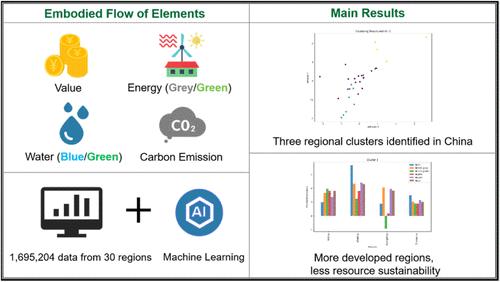中国资源流动的区域差异:基于MRIO和机器学习聚类的多维分析
IF 7.3
1区 化学
Q1 CHEMISTRY, MULTIDISCIPLINARY
引用次数: 0
摘要
在全球化和贸易自由化的背景下,经济、能源和生态的和谐发展已成为一个重要的全球性问题。能源、水资源和碳排放的区域间流动对经济增长的影响越来越大。然而,中国不同地区在资源禀赋和消费方面存在显著差异。为了弥合这些区域差距,定量理解资源的多维互动,本研究提出了一个基于投入产出模型的资源蕴含流动框架,从货币贸易、化石能源和可再生能源、蓝水和绿水以及碳排放六个维度对中国30个地区的资源流动进行了定量表征。此外,它还利用人工智能算法对中国各区域的资源利用和环境差异进行了综合聚类和分析,从而对每个区域的资源可持续指数进行了定量评估。结果表明:北部和西部资源集约区(集群1)资源可持续发展评价指数(SDI)均值为- 0.68,表明资源主要处于产出状态;中东部生产型区域(集群2)的平均SDI约为0.10,资源利用相对平衡,区域可持续性较好;经济和消费驱动的发达地区(集群3)平均SDI高达1.31,资源净进口和环境压力较大。本文强调了区域资源可持续性的显著差异,揭示了从贸易角度分析能源和生态资源对于实现区域更均衡发展的重要性。本文章由计算机程序翻译,如有差异,请以英文原文为准。

Regional Differences Reflected in Resource Flow in China: Multidimensional Analysis Integrating MRIO and Machine Learning Clustering
In the context of globalization and trade liberalization, the harmonious development of the economy, energy, and ecology has become a critical global issue. The inter-regional flows of energy, water resources, and carbon emissions play an increasingly influential role in economic growth. However, there are significant differences in resource endowment and consumption among different regions of China. To bridge these regional gaps and enable a quantitative understanding of multidimensional resource interactions, this study presents a resources embodied flow framework based on input-output model, quantitatively characterizing resources flows across 30 regions of China from six dimensions: monetary trade, fossil energy and renewable energy, blue water and green water, as well as carbon emissions. Furthermore, it carries out artificial intelligence algorithms to conduct a comprehensive clustering and analysis of resource utilization and environmental disparities across various regions in China, enabling a quantitative assessment of each region’s resources sustainability index. The findings identify three distinct regional clusters: the average resources sustainable development evaluation index (SDI) of the northern and western resource-intensive areas (Cluster 1) is −0.68, indicating that the resources are mainly in the output state; The average SDI of the central and eastern production-oriented regions (Cluster 2) is about 0.10, showing a relatively balanced utilization of resources and preferable regional sustainability; The average SDI of the developed region driven by economy and consumption (Cluster 3) is as high as 1.31, presenting serious net import of resources and environmental pressure. This article emphasizes the significant differences in regional resource sustainability and reveals the importance of analyzing energy and ecological resources from a trade perspective to achieve more balanced regional development.
求助全文
通过发布文献求助,成功后即可免费获取论文全文。
去求助
来源期刊

ACS Sustainable Chemistry & Engineering
CHEMISTRY, MULTIDISCIPLINARY-ENGINEERING, CHEMICAL
CiteScore
13.80
自引率
4.80%
发文量
1470
审稿时长
1.7 months
期刊介绍:
ACS Sustainable Chemistry & Engineering is a prestigious weekly peer-reviewed scientific journal published by the American Chemical Society. Dedicated to advancing the principles of green chemistry and green engineering, it covers a wide array of research topics including green chemistry, green engineering, biomass, alternative energy, and life cycle assessment.
The journal welcomes submissions in various formats, including Letters, Articles, Features, and Perspectives (Reviews), that address the challenges of sustainability in the chemical enterprise and contribute to the advancement of sustainable practices. Join us in shaping the future of sustainable chemistry and engineering.
 求助内容:
求助内容: 应助结果提醒方式:
应助结果提醒方式:


